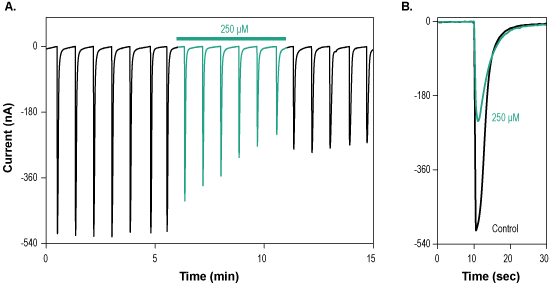Overview
- Kew, J.N. et al. (1998) Br. J. Pharmacol. 123, 463.
 Alomone Labs Ro 8-4304 hydrochloride inhibits NMDA receptor channels expressed in Xenopus oocytes.A. Time course of NR1/NR2A currents, that were elicited by transient stimulations with 100 µM glutamate and 100 µM glycine every 50 sec, while membrane potential was held at -80 mV. 250 µM Ro 8-4304 hydrochloride (#R-165), applied for 5 min (green), gradually inhibits current amplitude. B. Superimposed current traces from the recording shown in A. upon application of control (black) and of 250 µM Ro 8-4304 hydrochloride (green).
Alomone Labs Ro 8-4304 hydrochloride inhibits NMDA receptor channels expressed in Xenopus oocytes.A. Time course of NR1/NR2A currents, that were elicited by transient stimulations with 100 µM glutamate and 100 µM glycine every 50 sec, while membrane potential was held at -80 mV. 250 µM Ro 8-4304 hydrochloride (#R-165), applied for 5 min (green), gradually inhibits current amplitude. B. Superimposed current traces from the recording shown in A. upon application of control (black) and of 250 µM Ro 8-4304 hydrochloride (green).
Ro 8-4304 hydrochloride is a non-competitive antagonist of NMDA (N-methyl-d-aspartate) receptors. Ro 8-4304 effect is a voltage-independent and demonstrates selectivity to NR2B subtype of the NMDA receptor. The compound exhibits affinity for recombinant NMDA NR2B receptors that is at least 100 fold higher than NR2A receptors1. It has an IC50 value 0.39 mM1. Ro 8-4304 acts in an ifenprodil-like (another selective inhibitor of the NMDA receptor) mechanism. It was shown to be neuroprotective in both in vitro and in vivo models of ischaemia1,2.
NMDA receptors are heterotetrameric channels formed by the assembly of two obligatory GluN1 and two GluN2/GluN3 subunits. NMDAR plays an important role in a variety of cellular processes and brain functions such as, synaptic plasticity, addiction and stroke.
NMDA receptors mediate physiological functions such as learning and memory formation and play a role in glutamate excitotoxicity3.

